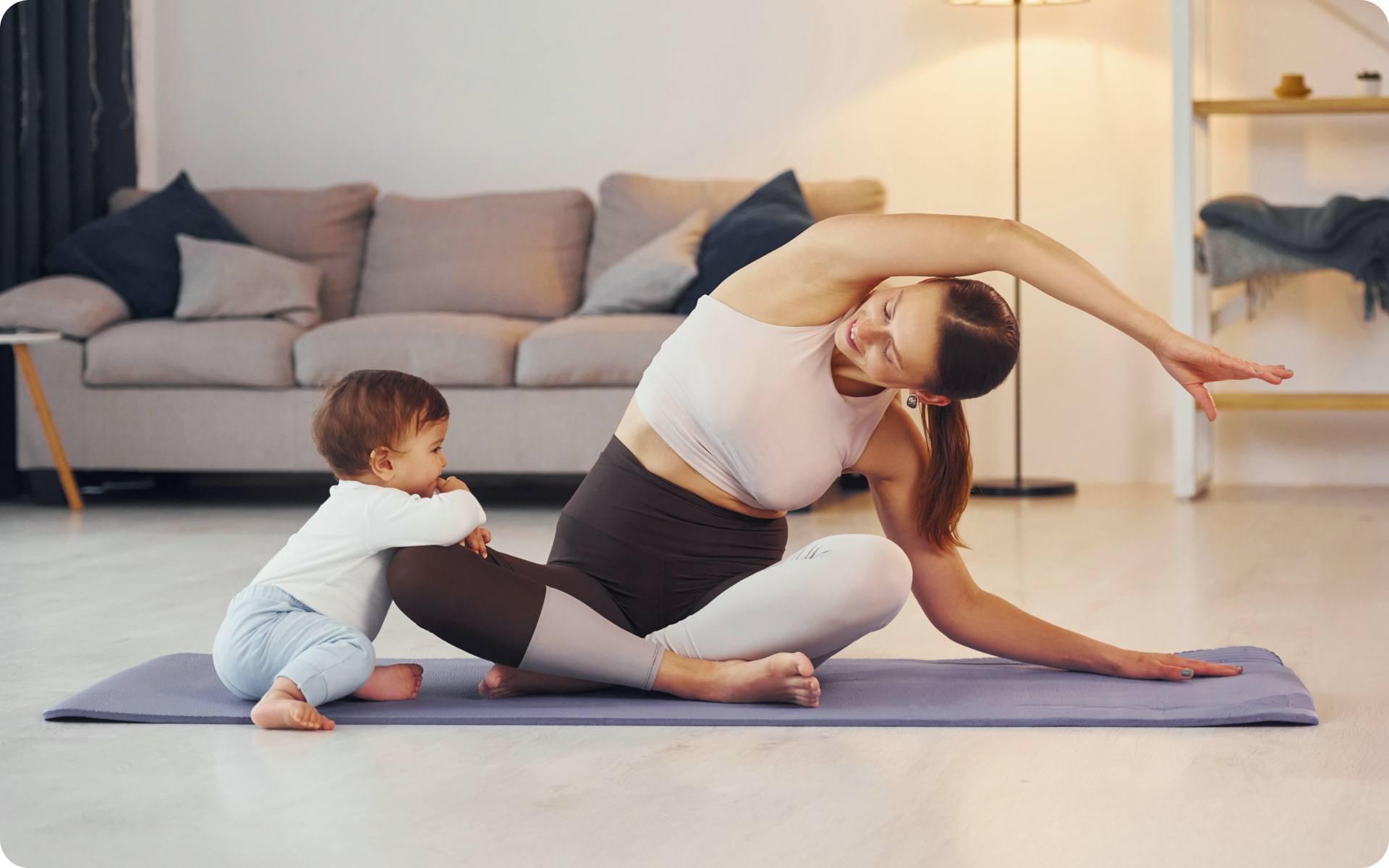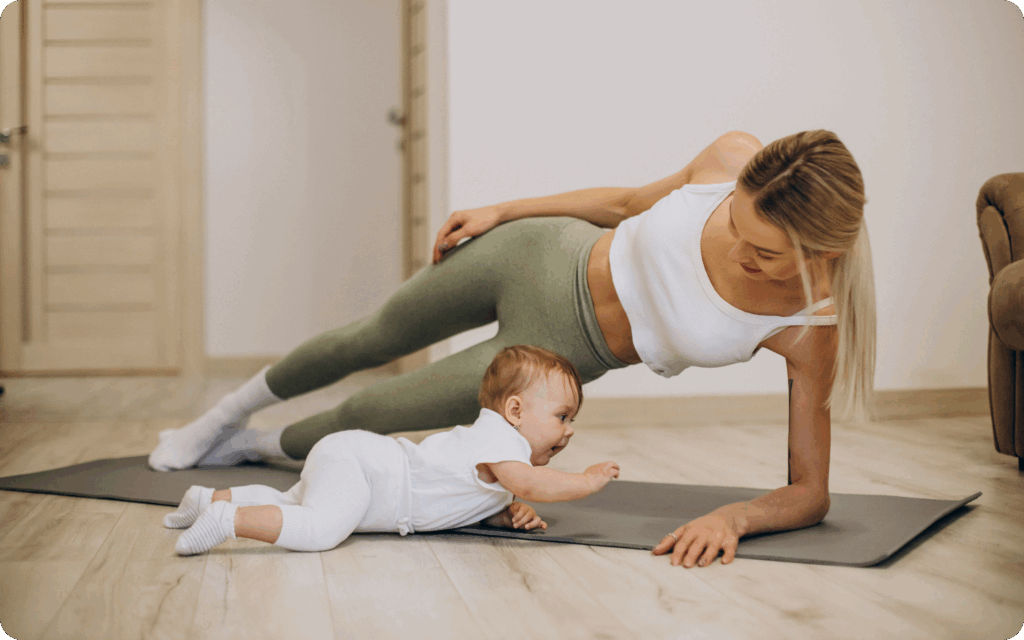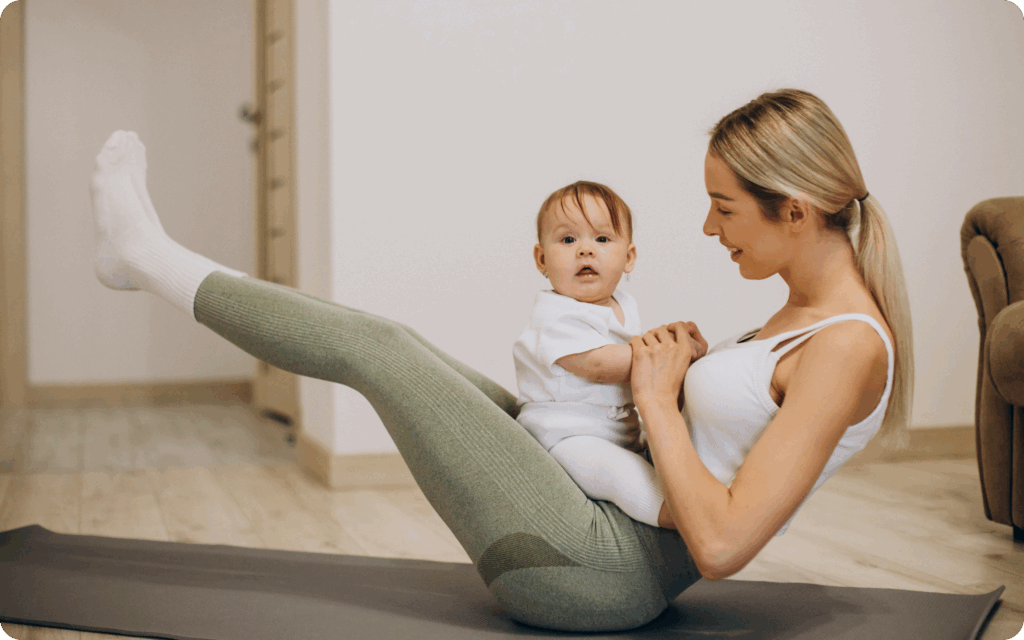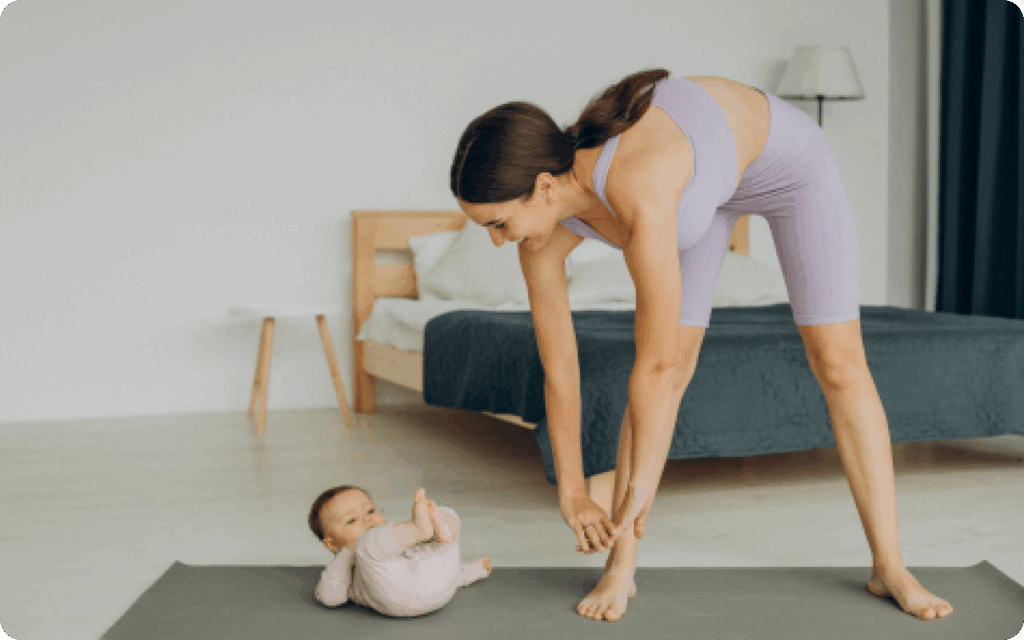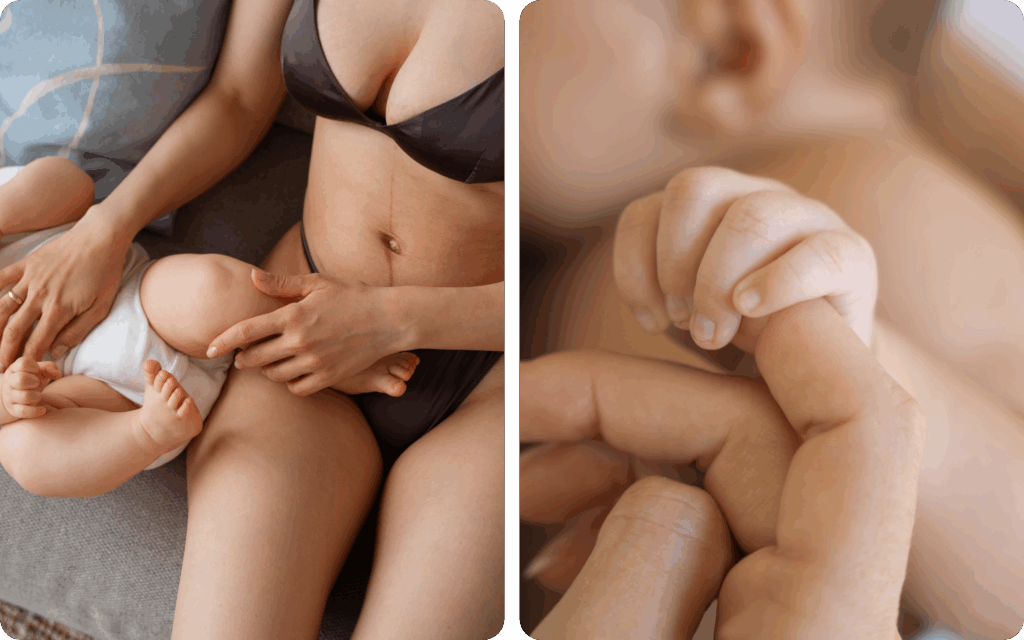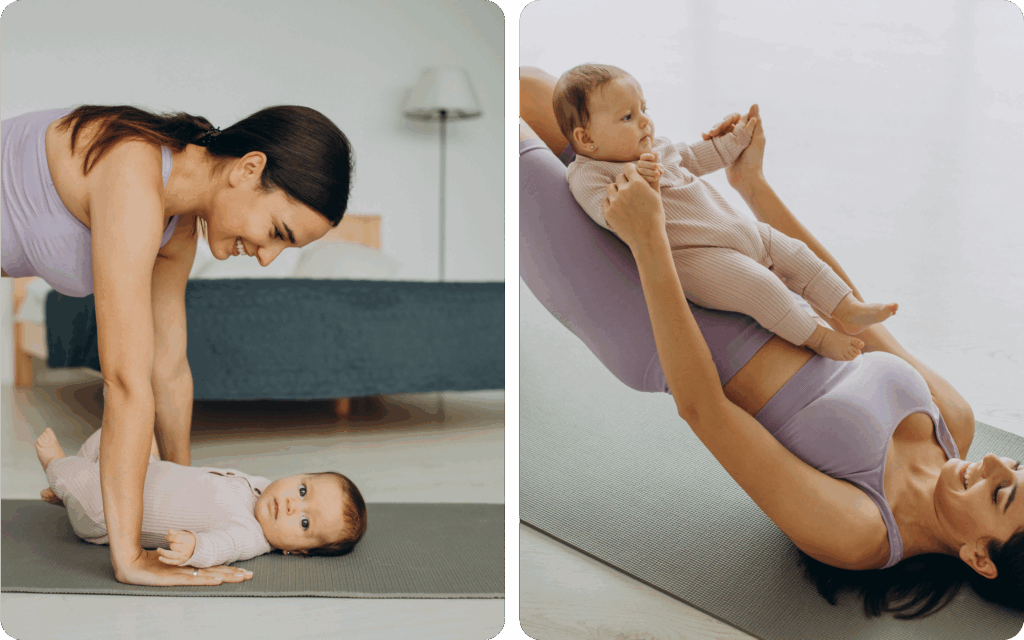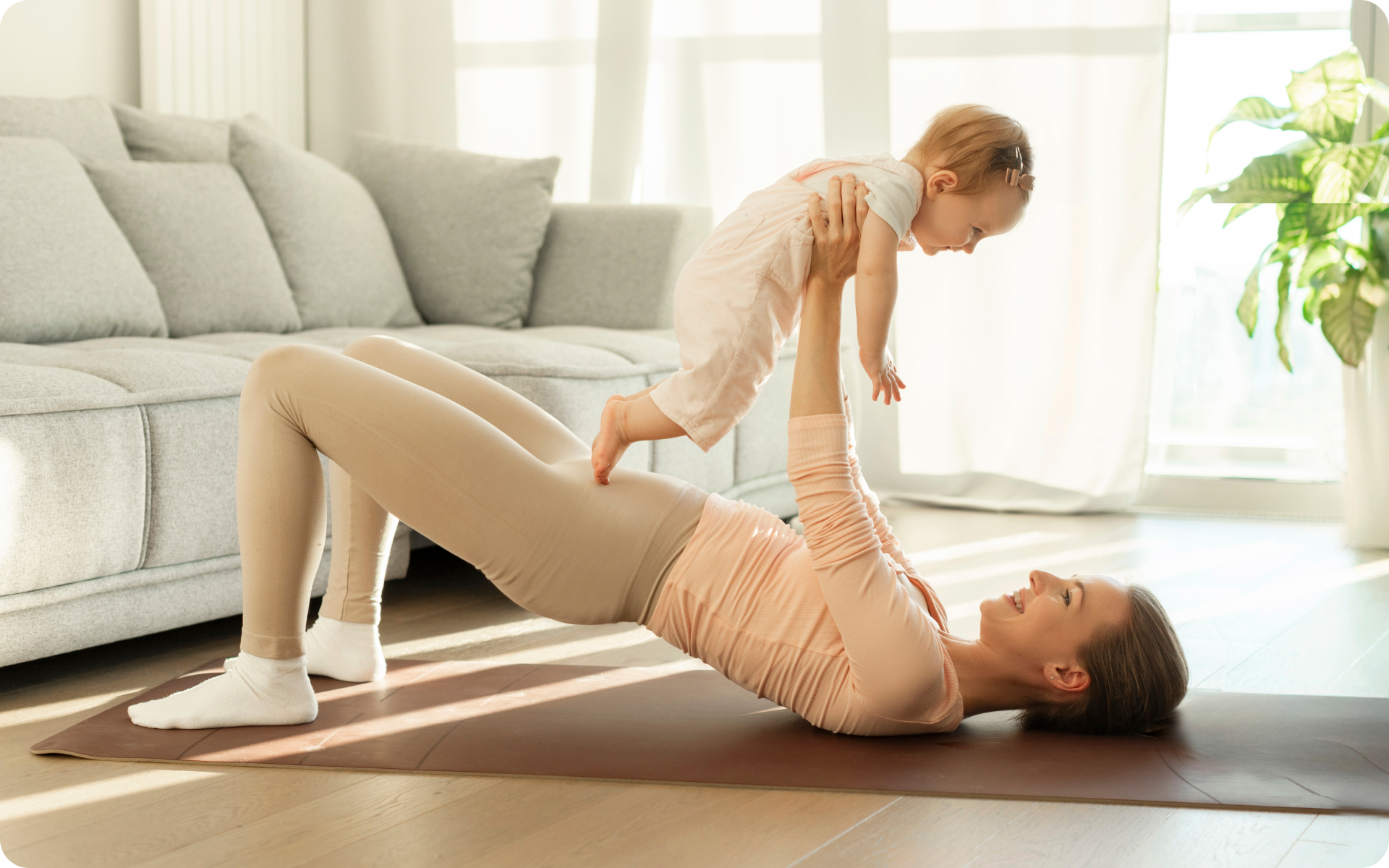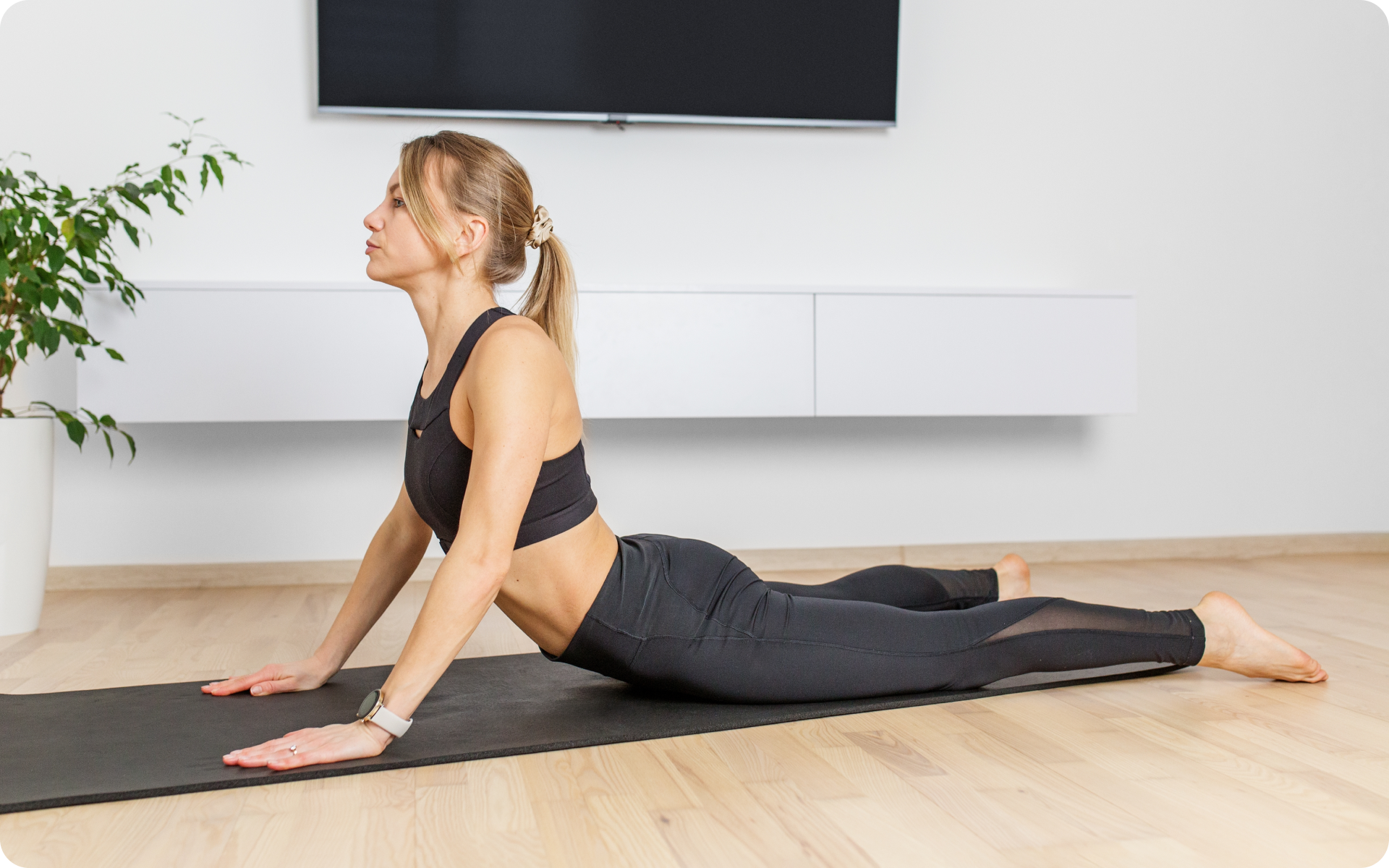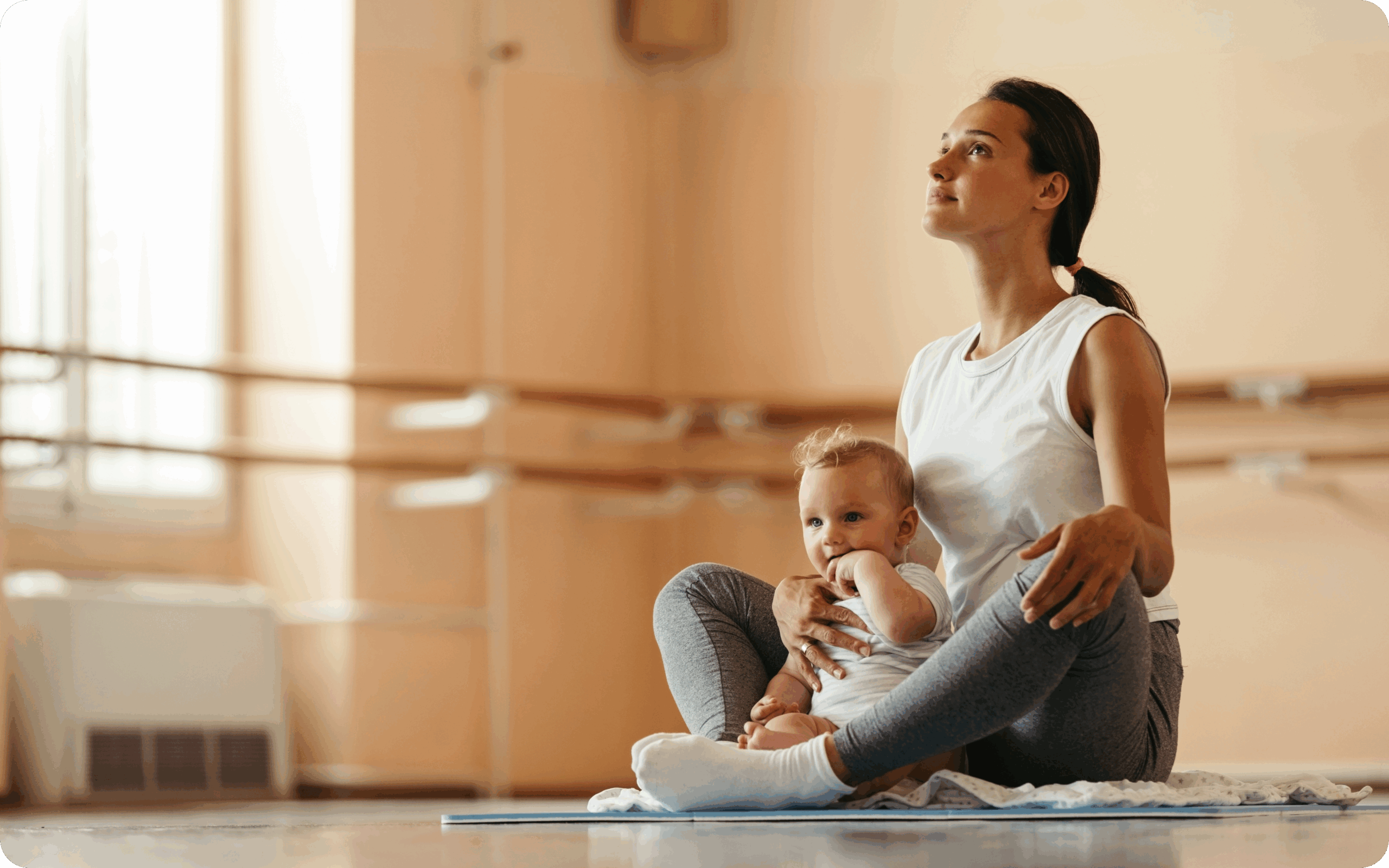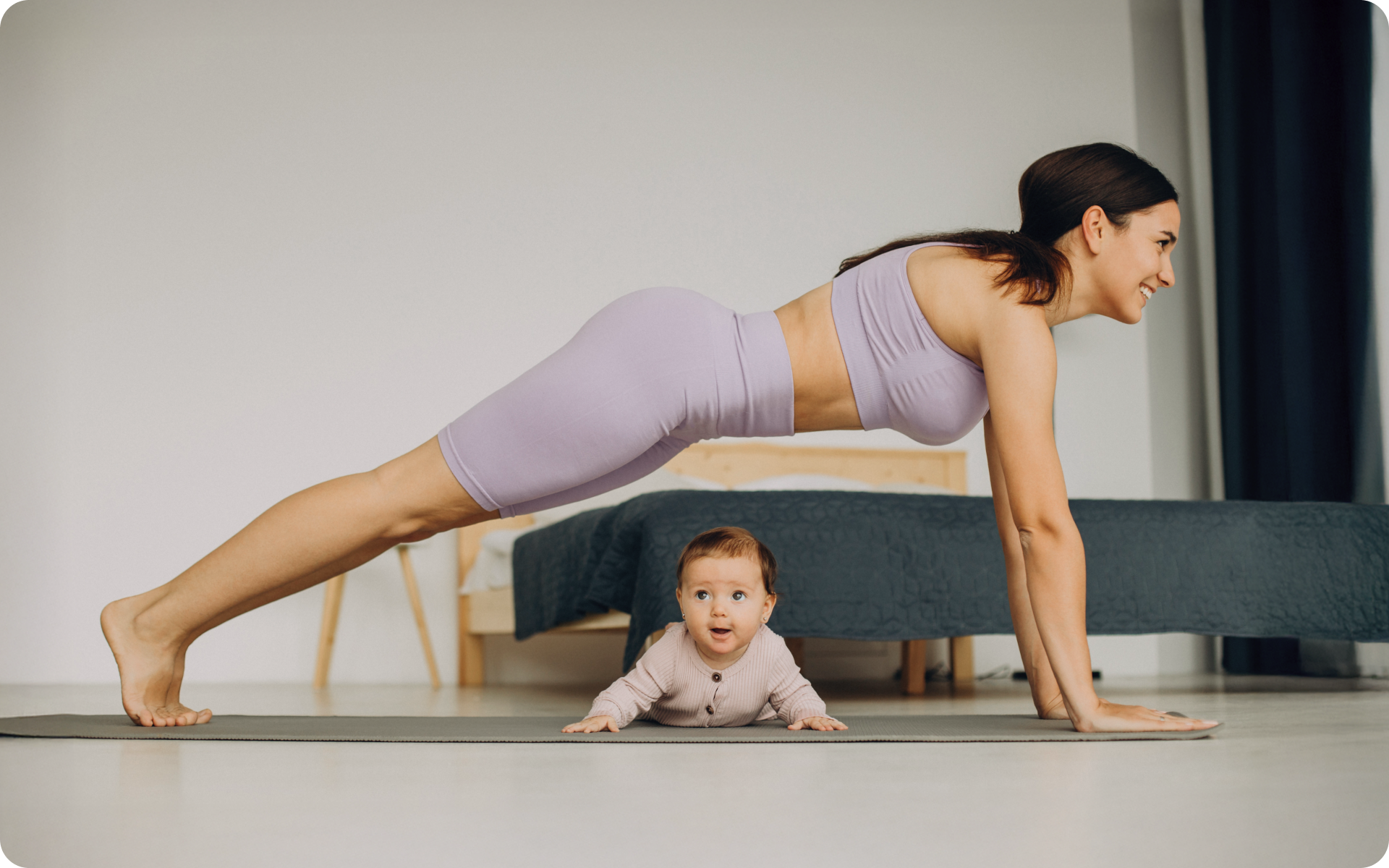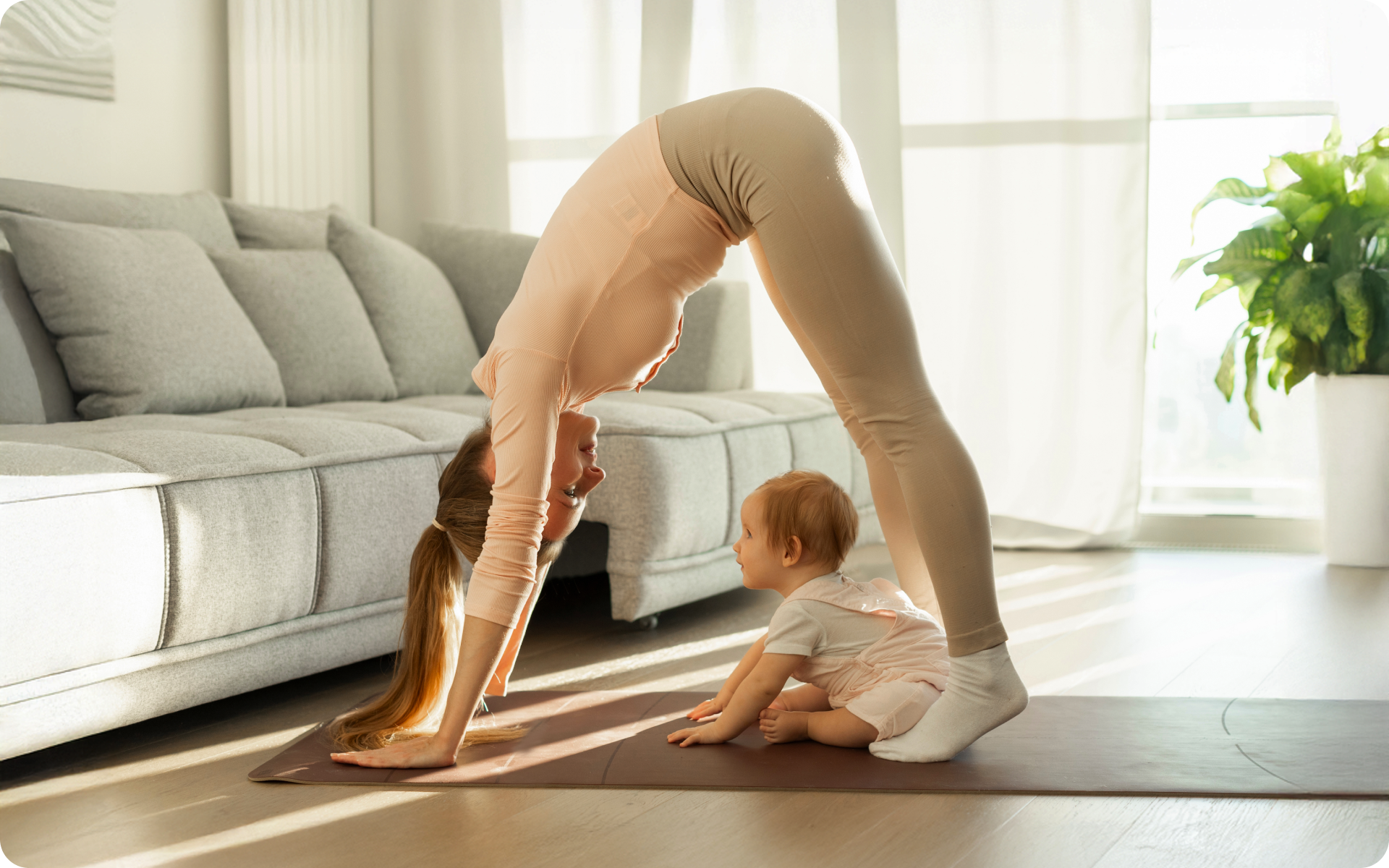Welcoming a baby into the world changes everything – your sleep, your emotions, and definitely your body. In the middle of feeding schedules and endless laundry, it’s normal to look in the mirror and feel like you don’t recognize yourself. A thoughtful postpartum workout routine can help bridge that gap, not by pressuring you to look a certain way, but by gently guiding you back to strength, stability, and self-connection.
Your body goes through so much during pregnancy and delivery. And after giving birth, it needs care just as much as your baby. Jumping into intense workouts too soon can backfire, so this is where gentle, targeted movement comes in. It helps strengthen your muscles and rebuild core strength without strain.
You don’t have to do it perfectly, or even every day. Movement that feels kind to your body is more than enough to start with. The best postpartum workout routine isn’t about perfection, it’s about progression. Rebuilding starts small, such as with slow pelvic tilts or breathing exercises that can reconnect you to your deep core.
As we go through our guide, we’ll explore how to ease into workouts gently, how to approach toning your core without overdoing it, and how your body and energy shift week by week. Whether you’re recently postpartum or a few months in, this routine is designed to work with your life, not against it.
Always consult your physician before you start any recovery fitness program to make sure that it’s suitable for your specific needs.
What is an Easy-to-Follow Postpartum Workout Routine?
Creating a postpartum workout routine that feels easy and realistic can be the difference between giving up early or actually building a habit. In the early weeks, your body is still recovering – even if you “feel fine”, your muscles, joints, and energy levels are still adjusting. Therefore, it’s important to focus on movement that feels nourishing, not exhausting.
One way to begin is with gentle breathing exercises that can help to re-engage your deep core (1). These aren’t fancy or difficult, but they can be powerful. Deep inhales that fill your lungs and slow, controlled exhales (while pulling your belly in) can help strengthen your core and support pelvic stability.
Another option is walking – not for calories, but for circulation and mental clarity (2, 3). Start with just 5-10 minutes. If you’re tired, that’s okay. If you feel okay to go longer? Do it, but just don’t push through discomfort or severe fatigue.
- Begin with this 3-step routine:
- 5 minutes of diaphragmatic breathing (lying down or seated)
- 10 slow squats using a chair for support
- 5-10 minutes of walking – indoors is okay
Simple moves such as pelvic tilts, seated marches, and side-lying leg lifts also help (4). They’re low-impact and can be done without equipment right in your living room. Sometimes it’s better to do these before your baby wakes up, but sometimes that just doesn’t happen. Let the routine mold to your life, not the other way around!
The foundation of a good postpartum workout routine is flexibility, not just in your muscles, but in how you approach it each day. If you’re curious about the mom exercise, check out our earlier article.
Read more: Busy Mom Pilates Challenge: Pamper Yourself for Those Little Stars!
How to Tone the Stomach After a Baby
Toning your stomach after pregnancy can feel like climbing a hill that keeps shifting underneath your feet. Many moms want to know when they’ll “get their abs back”, but the truth is, postpartum core recovery isn’t about visible six-packs. It’s about gently rebuilding the deep core muscles that were stretched and shifted during pregnancy, particularly those that help support your spine and help your posture.
Before you dive into crunches or planks, it’s important to focus on foundational strength. Exercises such as diaphragmatic breathing, pelvic tilts, and modified bridges help reconnect your mind to your midsection (5, 6, 7). These may seem small, but they can create the base that all future strength is built on.
- Start here:
• Diaphragmatic breathing (5 reps, 3x daily)
• Pelvic tilts lying on your back (10 reps)
• Glute bridges with a towel under your hips for support (10 reps)
As you progress, you can slowly reintroduce more challenging moves, but don’t rush. Core muscles that were overstretched need gentle activation before any intense tightening, otherwise it may create more harm than good, particularly in cases where the core still feels unsteady.
Consistency here matters more than intensity. Doing a little bit often is way better than going hard once in a while. Sometimes it’s easy to forget, but progress doesn’t always look dramatic. To learn more about the tips for flat tummy after pregnancy, check out our in-depth article on the topic.
Whether you’re a workout beast or just a beginner making your first foray into the world of fitness and dieting – BetterMe has a lot to offer to both newbies and experts! Install the app and experience the versatility first-hand!
Can You Do Abs After Giving Birth?
Yes, but gently, and not right away. After childbirth, your abdominal muscles have been through a lot. During pregnancy, they stretched to make room for your baby, and in many cases, the space between the left and right sides of your abdominal wall remains stretched apart even after delivery. This is called abdominal separation, or more formally, diastasis recti (8).
- What is abdominal separation?
When the connective tissue (called the linea alba) between your left and right abdominal muscles gets stretched and weak, this causes the muscles to pull apart and creates a gap down the middle of your belly. - What is prolonged separation?
If that gap doesn’t naturally close after a few months, it’s called prolonged abdominal separation (9). This means your core is still recovering and needs specific help to regain function.
Trying to do traditional ab exercises such as crunches or sit-ups too early may increase pressure through the midline and feel uncomfortable. That’s why it’s important to take a step back and focus on deeper recovery first.
- Better alternatives to start with (10,11,12):
• Diaphragmatic breathing (helps reconnect the brain to your core)
• Heel slides or toe taps (gentle movement without added pressure)
• Modified side planks (low-impact support for deeper core muscles)
These types of moves are often included in a well-structured postpartum workout routine. And while they’re commonly used for core recovery, they also may support better posture and can ease pressure on your lower back – both of which are common struggles after birth (13). Starting with this foundation is particularly important in a postpartum workout routine, before adding more intense cardio or strength-based training.
Some days you’ll feel strong, and other days you won’t – that’s part of it. But trust the process, because it’s not about rushing, it’s about proper recovery. Your body is still working hard, even if it doesn’t always show it in the mirror right away.
And for every exercise you do, think about what your body’s telling you. If there’s discomfort, pressure, or bulging through the belly, pause and step back to the basics.
How Do I Strengthen My Core Postpartum?
Rebuilding your core isn’t just about “doing abs again”. After pregnancy and birth, many of your stabilizing muscles are temporarily out of sync as they’ve adapted to growing a baby, going through labor, and changing alignment.
A smarter approach looks at movement patterns, control, feedback, and layering force gradually. The postpartum workout routine you follow should respect that complexity and not attempt to reverse months of adaptation overnight.
Think of your core as a system, not just one muscle. It includes your pelvic floor, your deep transverse abdominal muscle, your spinal stabilizers (like multifidus), and your diaphragm. These muscles work as a unit to manage pressure, posture, and movement (14).
When one link is weak or misfiring, the whole chain gets thrown off. That’s why strengthening should start from low load and high control, and gradually introduce force and complexity.
- Muscle coupling matters more than isolation
Rather than training individual muscles in isolation, evidence supports exercises that engage multiple core components together as this improves motor control and functional carryover (15). - Feedback and performance quality are key
Several reviews emphasize that it’s not only which exercises you do, but how well you perform them (alignment, timing, breathing) that predicts whether you’ll reduce discomfort or improve function (16,17).
Here’s how to build smarter strength after childbirth:
- Start with neuromuscular retraining
Use diaphragmatic breathing and pelvic floor activation to help reestablish coordination between your deep core muscles (18). - Add controlled movement under light load
Gentle heel taps or supine marching trains your core to stay engaged during limb movement (19). - Introduce isometric holds and anti-movement drills
Side planks, bird-dogs, and resistance band anti-rotation work build endurance and control, not just brute strength (20). - Progress load slowly
After several weeks of consistent low-intensity work, you can start to load with light weights or resistance bands, but only if your alignment feels stable and there’s no doming, discomfort, or pressure.
Core stabilization exercises in postpartum women lead to greater improvements in lower-back discomfort, balance, and function, compared to general exercise alone. This reinforces the idea that specificity, not just movement, matters (16, 17).
If you’re following a postpartum workout plan at home, you can absolutely do this in a living room, using just a mat and resistance bands. What matters more than equipment is the order and intent behind your movements.
It’s tempting to jump ahead to fat burning or toning, but skipping these steps puts the outer body ahead of the inner support. Without this foundation, long-term strength gets compromised. And just cause you feel “fine” doesn’t mean your core has recovered. Go slow to go strong!
Read more: Postpartum Fitness: Your Weekly Plan to Get Back on Track
What’s a Light and Effective Postpartum Workout Routine?
A light routine doesn’t mean it’s not working – it just means it’s working with your body instead of against it. High-effort training can cause more harm than good, particularly during the early postpartum stage. Your muscles, ligaments, and core pressure systems are still recalibrating. A light approach respects your recovery, while still helping you rebuild control and strength from the inside out.
In fact, a properly structured light routine is often more sustainable than one that burns you out. It allows you to be consistent, even on days when you’re sleep-deprived, leaking, or holding a baby in one arm. The point isn’t to power through, it’s to support your body as it gradually restores balance, posture, and tension.
- Core focus areas in early postpartum weeks (1-6) (if approved by your healthcare provider):
• Pelvic floor breathing and control
• Gentle core reconnection (posterior tilts, heel slides)
• Hip and glute stability (side-lying clams, bridges)
• Mid-back mobility (cat-cow, thoracic extensions)
• Short walking intervals for circulation
If your goal includes toning your midsection, the first step is not crunches, it’s learning how to manage core pressure (21). That’s why some of the best tips for a toned tummy after pregnancy focus on breath, core tension, and alignment before anything else. When your deep core activates properly, your belly may start to appear flatter without forced ab workouts.
It’s also important to remember that recovery isn’t just movement – nutrition matters too. If you’re breastfeeding, a restrictive plan could slow your recovery or affect milk supply. Instead, a balanced eating plan should include enough calories to fuel recovery and lactation, while emphasizing protein, hydration, and blood sugar balance. This combo can support overall recovery and tissue repair, without compromising energy (22).
What Are the Best Exercises to Add to Your Postpartum Workout Routine?
Once your foundation is rebuilt – your breathing, pelvic floor, and deep core feel re-engaged – it’s time to layer in new challenges. However, this step doesn’t mean pushing hard right away. The best exercises to add now are those that reinforce strength without creating pressure, discomfort, or compensation.
- Effective additions to consider around 6-12 weeks postpartum (with clearance):
• Modified deadlifts using resistance bands
• Standing resistance rows to improve posture
• Half-kneeling presses (activates glutes and core)
• Step-ups or slow squats with a controlled tempo
• Side planks with top-leg lifts
These movements can train real-life strength, such as picking up your baby, holding a car seat, or carrying groceries without straining your back. They help your body move better, not just look better.
To track your progress and stay consistent, you may want to try a postpartum workout app. These can offer visual demos, reminders, and week-by-week progressions you can follow at home. Just make sure the app is designed by professionals who understand postpartum physiology. Some programs are made for “bouncing back”, not for supporting recovery, and this distinction matters a lot.
Always progress gradually and check in with your body. You’re not just building fitness, you’re building trust in your body again. Some days you’ll lift more, and other days you’ll need to rest. Both are part of the work!
Reasons why BetterMe is a safe bet: a wide range of calorie-blasting workouts, finger-licking recipes, 24/7 support, challenges that’ll keep you on your best game, and that just scratches the surface! Start using our app and watch the magic happen.
How Does Breastfeeding Impact Postpartum Workouts?
Breastfeeding and working out can go hand in hand, but they affect each other more than many people think. When you’re nursing, your body is already burning extra calories, using fluid, and shifting hormones. All of this plays a role in how you feel during movement, and how your body recovers from it.
Lactation requires energy (23). You’re using approximately 300-500 extra calories a day, depending on how often you’re feeding your baby. If you’re also exercising without adjusting your intake, this could leave you feeling depleted or dizzy. And dehydration can creep in fast, particularly with longer or sweatier workouts.
- Breastfeeding considerations for your postpartum workout routine:
• Stay well hydrated – make sure to drink water before, during, and after workouts
• Eat enough to support both milk production and recovery
• Wear a supportive bra (avoid compression that can block milk ducts)
• Plan workouts after feeding or pumping to reduce breast discomfort
• Look out for signs of fatigue as your body is already working harder overall
Another layer is hormones. While breastfeeding, estrogen levels can remain lower than usual, which may impact ligament strength and joint stability. That means moves that require balance or single-leg control may feel less stable or slightly achy (24).
This doesn’t mean that you shouldn’t move – it just means that you should listen to your body. A balanced postpartum workout routine during breastfeeding is possible and beneficial, but it requires flexibility. On some days your energy will dip, and on others you’ll surprise yourself. Either way, both movement and milk-making can coexist, as long as you’re fueling and pacing yourself properly.
Our previous post goes into great detail about the breastfeeding diet to lose weight.
Start with gentle movement and core restoration, then add strength and cardio progressively. Combine this with a breastfeeding-suitable, nutrient-dense eating pattern for sustainable fat loss. Warning signs include pelvic heaviness, leaking, core bulging, joint discomfort, or exhaustion that worsens after activity. If you feel worse instead of stronger, it’s time to scale back and consult your doctor or healthcare provider to make sure your recovery is on the right track. Eventually, yes, but only after you’ve rebuilt core strength, resolved any instability, and received medical clearance. Jumping into HIIT too soon could delay your recovery. You can swim once vaginal bleeding (lochia) has fully stopped and any incisions or tears have recovered, which is usually at around 4-6 weeks, with clearance from your medical provider.Frequently Asked Questions
How do I reduce my weight after delivery?
What are signs that I’m overdoing it postpartum?
Can I do HIIT workouts postpartum?
Can I go swimming postpartum?
The Bottom Line
A gentle and effective postpartum workout routine isn’t about snapping back, it’s about rebuilding from the inside out. Your body has gone through months of structural changes and done an amazing thing in giving birth to another human, and recovery takes thoughtful movement, not intensity. From core reconnection and pelvic floor support to smarter strength and mobility, the journey is layered, but deeply worthwhile.
It’s okay to start small and it’s okay to move slowly. What matters is doing the right things at the right time with consistency and care. Whether you’re working out at home, following a plan, or using a postpartum workout app, what you need most is patience and trust in your body’s ability to restore itself.
Strong looks different now. And it starts right here with breath, intention, and the strength to begin again.
DISCLAIMER:
This article is intended for general informational purposes only and does not serve to address individual circumstances. It is not a substitute for professional advice or help and should not be relied on for making any kind of decision-making. Any action taken as a direct or indirect result of the information in this article is entirely at your own risk and is your sole responsibility.
BetterMe, its content staff, and its medical advisors accept no responsibility for inaccuracies, errors, misstatements, inconsistencies, or omissions and specifically disclaim any liability, loss or risk, personal, professional or otherwise, which may be incurred as a consequence, directly or indirectly, of the use and/or application of any content.
You should always seek the advice of your physician or other qualified health provider with any questions you may have regarding a medical condition or your specific situation. Never disregard professional medical advice or delay seeking it because of BetterMe content. If you suspect or think you may have a medical emergency, call your doctor.
SOURCES:
- The Effects of Postpartum Exercise on Maternal Health and Recovery: A Systematic Review (2025, sciencedirect.com)
- Exercise and Physical Activity During Pregnancy and Postpartum Periods: A Review (2021, pubmed.ncbi.nlm.nih.gov)
- The Effect of Exercise Interventions on Postpartum Depression and Physical Recovery (2021, biomedcentral.com)
- Postpartum Exercise and Pelvic Floor Function: Evidence-Based Recommendations (2019, pmc.ncbi.nlm.nih.gov)
- Exercise Programs for Women in the Postpartum Period: A Systematic Review (2021, pmc.ncbi.nlm.nih.gov)
- Impact of Physical Activity on Postpartum Weight Retention and Mental Health (2022, kjfm.or.kr)
- A Return to Running Program for the Postpartum Client: A Case Report (2008, researchgate.net)
- Postpartum Pelvic Floor Rehabilitation Through Core Stability Exercises (2022,pmc.ncbi.nlm.nih.gov)
- The Relationship Between Physical Activity, Sleep, and Fatigue in Postpartum Women (2025, pmc.ncbi.nlm.nih.gov)
- Effect of Exercise on Postpartum Weight, Depression, and Sleep Quality (2024, pmc.ncbi.nlm.nih.gov)
- Effectiveness of a Structured Exercise Program for Postpartum Women: A Randomized Trial (2022, pmc.ncbi.nlm.nih.gov)
- Rehabilitation of the Postpartum Runner: A Four-Phase Approach (2022, researchgate.net)
- Postpartum Exercise: How and When to Get Started (2024, nghs.com)
- Postpartum Recovery and the Role of Physical Therapy in Pelvic Health (2023, kansascity.edu)
- Exercise Interventions for Postpartum Women: Impact on Body Composition and Mood (2019, pmc.ncbi.nlm.nih.gov)
- Effects of Core Stabilization Training on Pelvic Floor Function in Postpartum Women (2019, pmc.ncbi.nlm.nih.gov)
- Efficacy of Pelvic Floor Muscle Training for Postpartum Women with Incontinence (2023, jptrs.org)
- Postpartum Exercise and the Risk of Pelvic Floor Disorders: A Longitudinal Study (2024, pmc.ncbi.nlm.nih.gov)
- Role of Core Stability in Postpartum Rehabilitation: A Controlled Study (2022, pmc.ncbi.nlm.nih.gov)
- Stabilization Exercise Affects Function of Transversus Abdominis and Pelvic Floor Muscles in Women with Postpartum Lumbo-Pelvic Pain: A Double-Blinded Randomized Clinical Trial Study (2019, researchgate.net)
- Effects of a Pilates-Based Rehabilitation Program on Postpartum Pelvic Pain and Core Function (2024, pmc.ncbi.nlm.nih.gov)
- Scientific Overview of Dietary Guidelines Advisory Committee Report 2020–2025 (2020, snacintl.org)
- Exercise and Pelvic Floor Muscle Function During and After Pregnancy (2005, pubmed.ncbi.nlm.nih.gov)
- Postpartum Exercise and Weight Management in Women: A Review (2018, pmc.ncbi.nlm.nih.gov)
